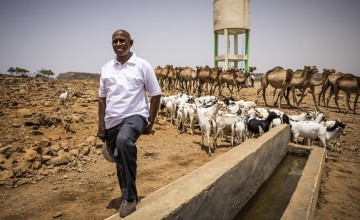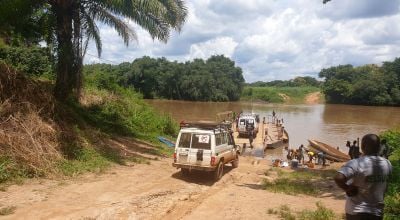
Read our 2023 annual report

Knowledge Hub
We get it: Irrigation isn’t the most exciting topic that we cover in our work. But it’s a key ingredient in the fight against world hunger.
It’s also a subject that makes Mubarak Mohamed, Concern's Programmes and Coordination Manager in Somaliland, light up with joy when it comes up in conversation. In ten years with Concern, Mubarak has worked on many projects in his community. But, as a hydrologist, he’s especially proud of one project in particular.
“I can't imagine my happiness now,” he says, surveying the fruits of his labour in the Borama District of Awdal - a region in the northwest corner of Somalia that shares a border with Djibouti.
“I remember how the place was previously.”

Running dry
For more than a decade, Somalia has been at the centre of a devastating drought. In fact, since 2011, Somalia has had only one proper rainy season - in 2013 - with all other years falling far short of the norm of two rainy seasons per year. The current drought across the Horn of Africa has been declared the worst to hit the region in 40 years.
This pattern has left Somalia ranking consistently among the hungriest countries in the world, with nearly 50% of the country’s population facing some form of food insecurity. A famine (brought on in part by failed rains) in 2011 killed more than a quarter of a million people, many of whom were children under the age of 5. Sadly, many parts of the country are once again risking a declaration of famine in response to the latest escalation of drought.
“We’ve had less and less each year. Last year, all three farms produced just one 50-kilo bag of sorghum. It would usually be 25 per farm,” says Abdi Jama, a 55-year-old pastoralist and fellow Broaman who runs three farms.
“This year is the worst year for my family, because I didn’t have anything from the farm. The animals also wilted because this is a drought. We used to use the milk; my wife used to sell it at the market. I used to get food from the farm. This year, I lost both.”
"My wife used to sell [milk] at the market. I used to get food from the farm. This year, I lost both."
Why irrigation matters
In areas where water stress is high, finding ways to get water into farms for the best possible harvests is key. In a world faced with an increasingly global water crisis, irrigation matters in the fight against hunger. It allows us to maximise and extend the use of water (especially in the off-season) for keeping livestock and crops nourished.
This is especially true for high-value crops like vegetables, which are essential for both a family’s daily nutritional needs and their livelihoods.
Many irrigation systems are also quite simple. In Somalia, for example, one solution is to collect water from rainfall and store it in a basin lined with plastic film to feed fruit crops. In Niger, solar power systems are used to pump water from shallow wells into vegetable patches.

Leading a town to water
Irrigation brings water closer to home, and makes it less of a precious commodity. “We used to go 10 kilometres to get water,” Abdi recounts. A father of 11, he was the main water-gatherer until his children became old enough to make the trek themselves. They would leave early in the morning and return late in the afternoon to avoid the desert sun and heat.
For the last three years, Concern trucked in water for the area during the dry seasons. However, this wasn’t a cost-effective option (it ran between 50,000 and 60,000 shillings a year, approximately €85 to €100). It also wasn’t enough water for every family’s needs - approximately two jerry cans of water a day for two months.
“We used it for animals and the small children,” says Abdi.

Trading trucks for drills
Water trucking is a good short-term response to emergencies - such as an earthquake that interrupts local services - but it doesn’t solve the problem. “Instead of water trucking, we needed to send a water system,” explains Concern’s Mubarak Mohamed.
Mubarak and his team identified three villages in Borama District close enough to each other to share a water system.
Despite being the driest villages in the region, they found enough underground water to support 600 families. They dug a borehole to access this water, but then they decided to go deeper: Drilling 10 metres further down, they discovered enough water to serve twice as many families. A tank was built to store about 125 barrels of water.
“We constructed these two points of human consumption and four animal troughs: two for sheep and goats, and two for camels and cows,” Mubarak points out, noting as well the ways they used the natural environment to improve the water system.
“We also installed a solar system, as there is so much sun throughout the year, which reduced spending costs.”

Making it flow
“The difference is huge. The water is now close to the households. People used to walk long distances, spending all their time collecting water,” says Abdi - who is also a volunteer committee member for the Dhidhid Water Project, overseeing maintenance and upkeep.
“People use it to work on their farms and to look after the animals.”
The water project has been so successful, its reach has expanded. “The system was primarily made for these three communities, however due to the drought in the coastal area, people have shifted here for water and grazing,” says Mubarak. Two additional communities make use of the local water points.
“During the assessment, I was seeing all the women who were coming all the way to the village we were at - climbing these high cliffs and mountains with four jerry cans,” Mubarak recalls. “It was my initiative to combine the two, instead of individual villages getting these tanks and three or four buckets, we made one big programme like we have now done.”
Irrigation and hunger: The missing connection
Mubarak points out that the primary goal of the Dhidhid Water Project is to serve people and animals, not to irrigate farms. However, residents of the area have both flocks and farms.
“After this project, people can see that water is plentiful. So people will now use irrigation for farms in the future and this area will become full of farms,” says Abdi. “People might get money to drill for water as it is four metres below the surface, so they may make boreholes and they will be able to get it too.”
Irrigation methods connected to local water sources are often low-cost and easy to build locally: think of solar-powered pumps and hose-and-drip systems. In addition to bringing in more income to community members who build and maintain these systems, they also bring clean water closer to the farms that need it the most.
A little over 4,000 kilometres south of Somaliland, some communities are already seeing how simple irrigation systems are helping the fight against hunger. The simpler, the better. “It was challenging to most of the farmers in the district, especially in the running and maintenance costs,” says irrigation engineer Jones Ng'ombeyakuyera of the petrol-fuelled pumps that had been used to conserve and deliver water in Malawi’s Mwanza District.

Switching to solar-powered pumps was also an investment, but it has lowered the running costs enough that Jones is optimistic about how local farmers in an area of the country hit hard by climate change and unpredictable rains are benefitting from the lower-cost (and eco-friendlier) option.
“The farmers in the district have really appreciated it,” he says of the switch, adding that food security has improved as a result.
He’s ambitious about how these systems can be scaled up, so that farmers can also begin to “improve their economic status by selling the extra produce [grown thanks to] the irrigation schemes.”





